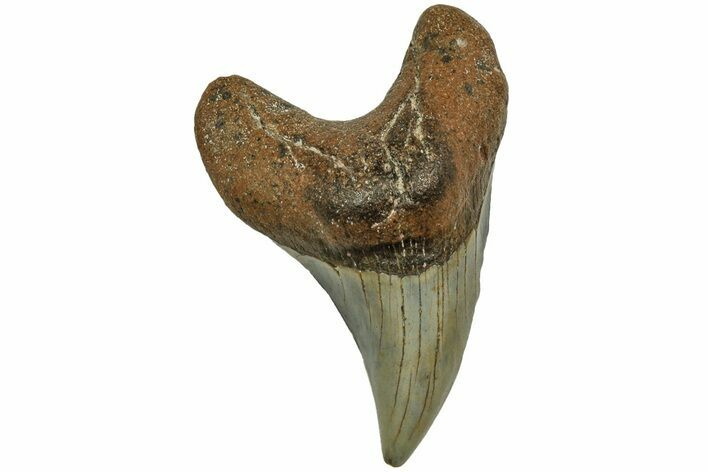This Specimen has been sold.
Rare, 2.62" Fossil Benedini Shark Tooth - North Carolina
This is a rare, 2.62" long fossil shark (Parotodus benedeni) tooth found off the coast of North Carolina. It was found by commercial divers collecting "the ledges" in about 100 feet of water. The tooth would have eroded out of the Pungo River Formation when sea levels were lower and the area where these teeth are found was at the shoreline.
Parotodus (or, the false mako shark), is an extinct genus of mackerel shark that lived between the Eocene and Pleistocene epochs, or 53 to 1 million years ago. Their recurve teeth are prized by fossil collectors because of their relative absence from the fossil record. This scarcity isn’t due to a limited range, but rather from a perceived open ocean lifestyle, unlike many other shark species whose teeth appear frequently at coastlines.
Parotodus teeth are recovered from fossil deposits both in and around the Pacific and Indian Oceans. While the occasional Parotodus tooth is found on a continental coastline, most often they will be dredged from the undersea nodules of deposits on mid-ocean islands. These occurrences further the idea that Parotodus lived its life in the open ocean, much like modern blue sharks.
The distinctly sickle-shaped curve of Parotodus teeth make them easily identifiable, with only a slight resemblance to those of C. planus. This attractive curve and relative lack of feeding damage are major draws for fossil collectors who seek out these rare teeth. Paleontologists are inclined to believe that Parotodus teeth maintained such good condition by feeding on soft-bodied animals for the majority of their diet.
Over geologic time Parotodus increased in size from a relatively small stature to upwards of 25 feet in length, making it one of the biggest sharks in the Neogene. Given this estimate, scientists place Parotodus in the mega-tooth shark category, shared by white sharks and threshers. This classification should be taken with a grain of salt, as Parotodus fossils are very rare and ambiguous when they are discovered.
Parotodus teeth are recovered from fossil deposits both in and around the Pacific and Indian Oceans. While the occasional Parotodus tooth is found on a continental coastline, most often they will be dredged from the undersea nodules of deposits on mid-ocean islands. These occurrences further the idea that Parotodus lived its life in the open ocean, much like modern blue sharks.
The distinctly sickle-shaped curve of Parotodus teeth make them easily identifiable, with only a slight resemblance to those of C. planus. This attractive curve and relative lack of feeding damage are major draws for fossil collectors who seek out these rare teeth. Paleontologists are inclined to believe that Parotodus teeth maintained such good condition by feeding on soft-bodied animals for the majority of their diet.
Over geologic time Parotodus increased in size from a relatively small stature to upwards of 25 feet in length, making it one of the biggest sharks in the Neogene. Given this estimate, scientists place Parotodus in the mega-tooth shark category, shared by white sharks and threshers. This classification should be taken with a grain of salt, as Parotodus fossils are very rare and ambiguous when they are discovered.
SPECIES
Parotodus benedini
LOCATION
North Carolina Coast
FORMATION
Pungo River Formation
SIZE
2.62" long
CATEGORY
SUB CATEGORY
ITEM
#208092
We guarantee the authenticity of all of our specimens.
 Reviews
Reviews












